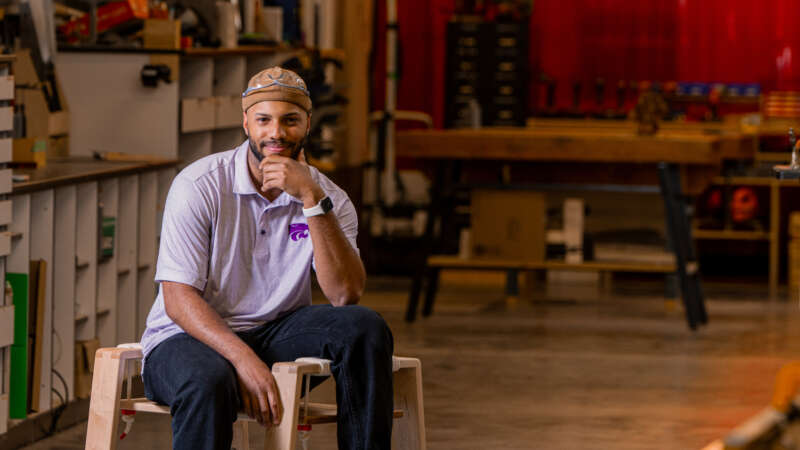K-State Architecture, Planning and Design students combat homelessness by building affordable and environmentally sustainable housing.
The unfortunate reality of homelessness remains at the forefront of society. With millions having no other choice but to live on the street, many organizations and programs continue to search for ways to aid in combating this issue and helping those in need. Kansas State University’s Architecture, Planning and Design students have come together with a plan to build affordable housing for those in need of a helping hand.
“When I began these projects with my studio, I was most inspired by a two-fold problem: the dire shortage we have in the U.S. for affordable housing, and the environmental impacts of the houses we live in,” said Michael Gibson, associate professor in architecture. “This is not an abstract problem either, because so many of us can personally relate to these problems; we all have been or know somebody who has been affected by the affordable housing crisis, so we understand how important homes are.”
While the main goal of the project is to give people dealing with homelessness a safe and affordable home to live in, the housing projects are built upon a foundation of environmental sustainability and provide what Gibson calls “net zero energy.”
“When I started the studio, I called it The Net Positive Studio because I wanted our projects to be about more than energy efficiency,” Gibson said. “A ‘net zero’ house offsets the energy it uses with energy it generates on site, which is an important idea. But a net zero house can do so many more positive things. In this way, it is a great real-world project for design students to exercise their knowledge as soon-to-be professionals. They must research the problem, learn the tools and methods to solve it, design the house, and then figure out how to build it. The students learn how expansive their skills are as a team and what they can give the world as professionals. I believe it changes the way they will approach their work in the future, no matter what kind of architecture they practice.”
Gibson believes that the educational and sustainability aspects of these projects can have a far greater reach than Kansas State University. “Bringing affordable, net zero homes into communities in Kansas is about much more than trimming homeowners’ energy bills,” Gibson said. “By working on these projects, we can demonstrate to communities that sustainable housing can have much broader impacts, like improving households’ health and security. In this way the homes are educational projects extending far beyond KSU.”
The educational and personal benefits students have received from working on these innovative housing projects cannot be understated. “The most valuable aspect of our sustainable, affordable housing project was the importance of connecting with the community in order to uniquely tailor a design and construction strategy that fit their specific affordable housing needs,” said Grant Urban, who graduated in May 2020. “We actively engaged and listened to members of the community frequently to understand their design goals, energy-efficiency and affordability needs, to attain feedback that guided our research and designs toward a housing solution to achieve those ideas. As young design professionals, our ability to listen, communicate and learn to customize design solutions for the specific needs of our clients and communities are invaluable skills that we will carry into our professions beyond our academic careers.”
Urban also wanted to express how these projects made him connect with the community and the people he worked with on a personal level. “Many people hold the misconception that an architect’s main role is to make a building have a certain stylistic character or even wildly unique forms,” Urban said. “The truth is that our priority is designing specifically for the people using our designs. Without ensuring that a design is comfortable, safe and affordable for the individuals living in or using it, its stylistic character has little value. I value the personal relationships we created with the community for this project, which were crucial to achieving a successful, individualized, affordable and sustainable housing solution. I believe the value of creating strong relationships with others not only benefits one’s professional life but carries just as powerfully into one’s personal life.”
Urban hopes that other students and design professionals can build off what he and his fellow students created to fuel their own ideas. “I hope that other designers, architects and builders utilize the research and innovative design strategies that we implemented in our project and build upon them to create even better energy-efficient and affordable housing solutions for the future,” Urban said. “Our Net Positive Studio publishes all of the research and design conclusions from our sustainable, affordable housing projects solely for the purpose of allowing other professionals and communities to utilize the information for further affordable housing projects. We understand that no design is meant to be a fixed, one-size-fits-all, perfect solution. However, design and construction professionals should continually learn from their own, and others’ experiences, successes, and failures to find other new and creative ways to achieve sustainable and affordable housing solutions.”
These housing projects have been funded for their first two years by a Department of Energy grant and has had its materials provided by several places including Interstate Glass.
If you or your company are interested in supporting this project, contact Damon Fairchild, senior director of development for the College of Architecture, Planning and Design.
By James Dalton Burton



